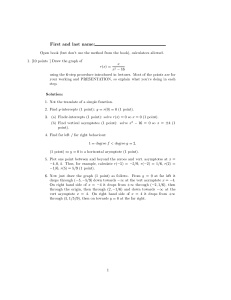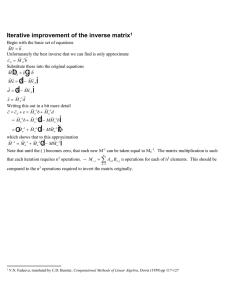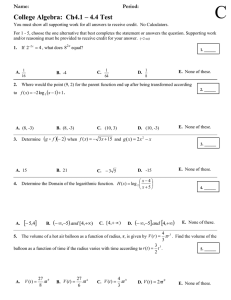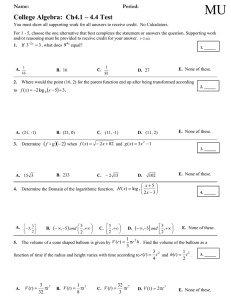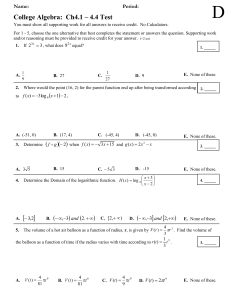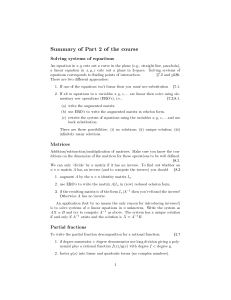First and last name: Codename:
advertisement
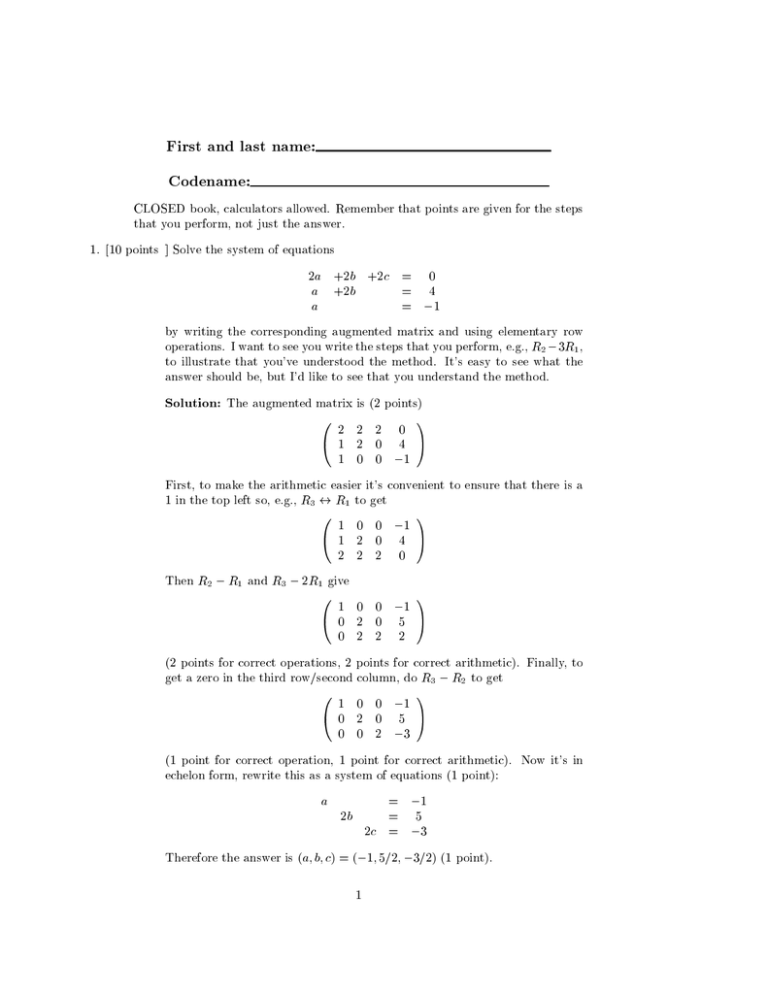
First and last name: Codename: CLOSED book, calculators allowed. Remember that points are given for the steps that you perform, not just the answer. 1. [10 points ] Solve the system of equations 2a +2b +2c = 0 a +2b = 4 a = ,1 by writing the corresponding augmented matrix and using elementary row operations. I want to see you write the steps that you perform, e.g., R2 , 3R1, to illustrate that you've understood the method. It's easy to see what the answer should be, but I'd like to see that you understand the method. Solution: The augmented matrix is (2 points) 02 @1 1 2 2 0 2 0 4 A 1 0 0 ,1 First, to make the arithmetic easier it's convenient to ensure that there is a 1 in the top left so, e.g., R3 $ R1 to get 0 1 0 0 ,1 1 @1 2 0 4 A 2 2 2 0 Then R2 , R1 and R3 , 2R1 give 0 1 0 0 ,1 1 @0 2 0 5 A 0 2 2 2 (2 points for correct operations, 2 points for correct arithmetic). Finally, to get a zero in the third row/second column, do R3 , R2 to get 01 @0 0 0 ,1 2 0 5 0 0 2 ,3 1 A (1 point for correct operation, 1 point for correct arithmetic). Now it's in echelon form, rewrite this as a system of equations (1 point): a = ,1 = 5 2c = ,3 2b Therefore the answer is (a; b; c) = (,1; 5=2; ,3=2) (1 point). 1 2. [10 points ] Draw the graph of r(x) = x2 x, 4 using the 6-step procedure introduced in lectures. Most of the points are for your working and PRESENTATION, so explain what you're doing in each step. Solution: (a) Not the translate of a simple function. (b) Find y-intercepts (1 point): y = r(0) = 0 (1 point). (c) i. Findx-intercepts (1 point): solve r(x) = 0 so x = 0 (1 point). ii. Find vertical asymptotes (1 point): solve x2 , 4 = 0 so x = 2 (1 point). (d) Find far left / far right behaviour: 1 = degree f < degree g = 2; (1 point) so y = 0 is a horizontal asymptote (1 point). (e) Plot one point between and beyond the zeroes and vert. asymptotes at x = ,2; 0; 2. Thus, for example, calculate r(,3) = ,3=5, r(,1) = 1=3, r(1) = ,1=3, r(3) = 3=5 (1 point). (f) Now just draw the graph (1 point) as follows. From y = 0 at far left it drops through (,3; ,3=5) down towards ,1 at the vert asymptote x = ,2. On right hand side of x = ,2 it drops from +1 through (,1; 1=3), then through the origin, then through (1; ,1=3) and down towards ,1 at the vert asymptote x = 2. On right hand side of x = 2 it drops from +1 through (3; 3=5), then on towards y = 0 at the far right. 3. [15 points ] Circle T or F according to whether you think the statement is True or False (the rst three are worth 2 points each, the last three are worth 3 points each): Solution: T F F T Any nonsquare matrix doesn't have an inverse. 01 The matrix @ 0 0 1 0 1 0 0 0 0 1 0 1 A is in row reduced echelon form. For the rational function (x + 1)(xx , 10)2 , the partial fraction decomposition is of the form x +a 1 + (x ,b10)2 . The graph of a rational function can cross one of its asymptotes. 2 F Suppose A is an m n matrix, B is an n r matrix and AB = 0. Then either A or B must have all entries equal to zero. A circle and a straight line may intersect in a single point. 4. [10 points ] Write the partial fraction decomposition for the rational expression T 4x2 , 1 : 2x(x + 1)2 [Hint: Eventually you'll have to solve a system of equations. Question 1 should be helpful!!! If it's not then move on to the next question now, but return and check through your solution to this question.] Solution: The partial fraction decomposition is (3 points) 4x2 , 1 = a + b + c ; 2x(x + 1)2 2x x + 1 (x + 1)2 for some constants a; b; c. To work out what a; b; c are, put the fractions over a common denomenator (1 point) a + b + c = a(x + 1)2 + b(2x)(x + 1) + c(2x) : 2x x + 1 (x + 1)2 2x(x + 1)2 Multiply out the polynomials on the numerator to give (1 point) ax2 + 2ax + a + 2bx2 + 2bx + 2cx : 2x(x + 1)2 Now gather the terms (1 point) (a + 2b)x2 + (2a + 2b + 2c)x + a : 2x(x + 1)2 This is equal to the fraction in the question, namely (1 point) 4x2 , 1 = (a + 2b)x2 + (2a + 2b + 2c)x + a : 2x(x + 1)2 2x(x + 1)2 The coecients must be equal, so you get three equations (2 points): 2a +2b +2c = 0 a +2b = 4 a = ,1 This is the system from question 1, so you know the answer is (a; b; c) = (,1; 5=2; ,3=2). Therefore (1 point) 4x2 , 1 = ,1 + 5=2 + ,3=2 : 2x(x + 1)2 2x x + 1 (x + 1)2 3 5. [10 points ] (a) Find the inverse of the matrix A= 3 ,3 ,2 3 ; or show that A has no inverse. Using the formula from lectures will get at most 3 marks out of 7 for this part. To gain full marks I want to see you perform several ERO's on a matrix which you create. If you have time, check your answer using matrix multiplication. Solution: Augment the 2 2 matrix by the identity (2 points) 3 ,3 1 0 ,2 3 0 1 Then reduce to row reduced echelon form (4 points): 31 R1 and 12 R2 give Then R2 + R1 gives 1 ,1 1=3 0 ,1 3=2 0 1=2 1 ,1 1=3 0 0 1=2 1=3 1=2 Then 2R2 gives 1 ,1 1=3 Then R1 + R2 gives 1 0 0 1 2=3 1 0 1 1 0 1 2=3 1 The identity appears on the left of this matrix, so A does have an inverse, namely (1 point) 1 1 , 1 A = 2=3 1 : (b) Using your answer to part (a), solve the system of equations 3x ,3y = 4 ,2x +3y = 6 : The system is a single matrix equation AX = B for the matrix A as in part (a) above (1 point). Since A has an inverse, the solution is (2 Solution: points) X= x y = A,1 B = 4 1 1 2=3 1 4 6 = 10 26=3 :


